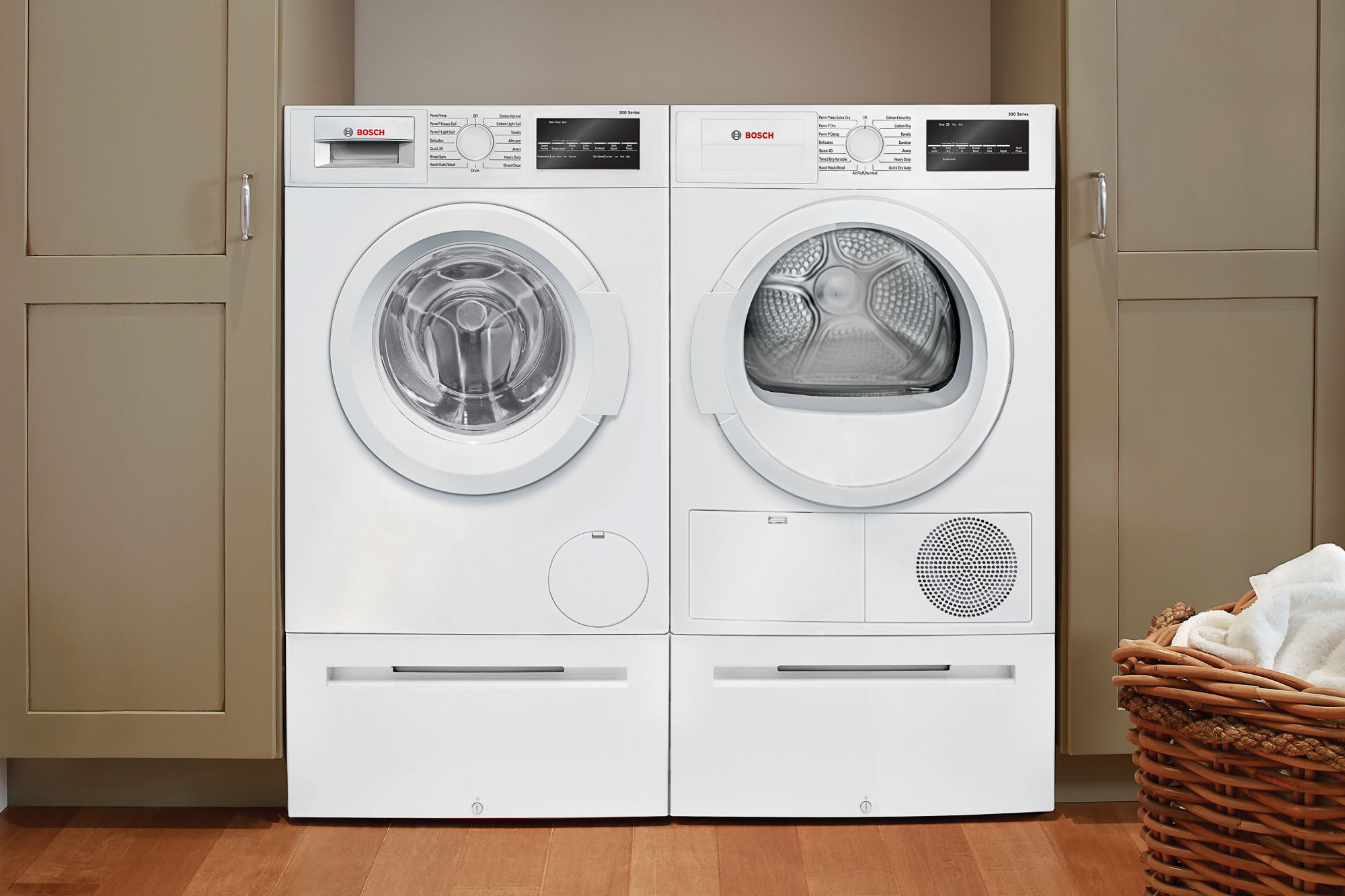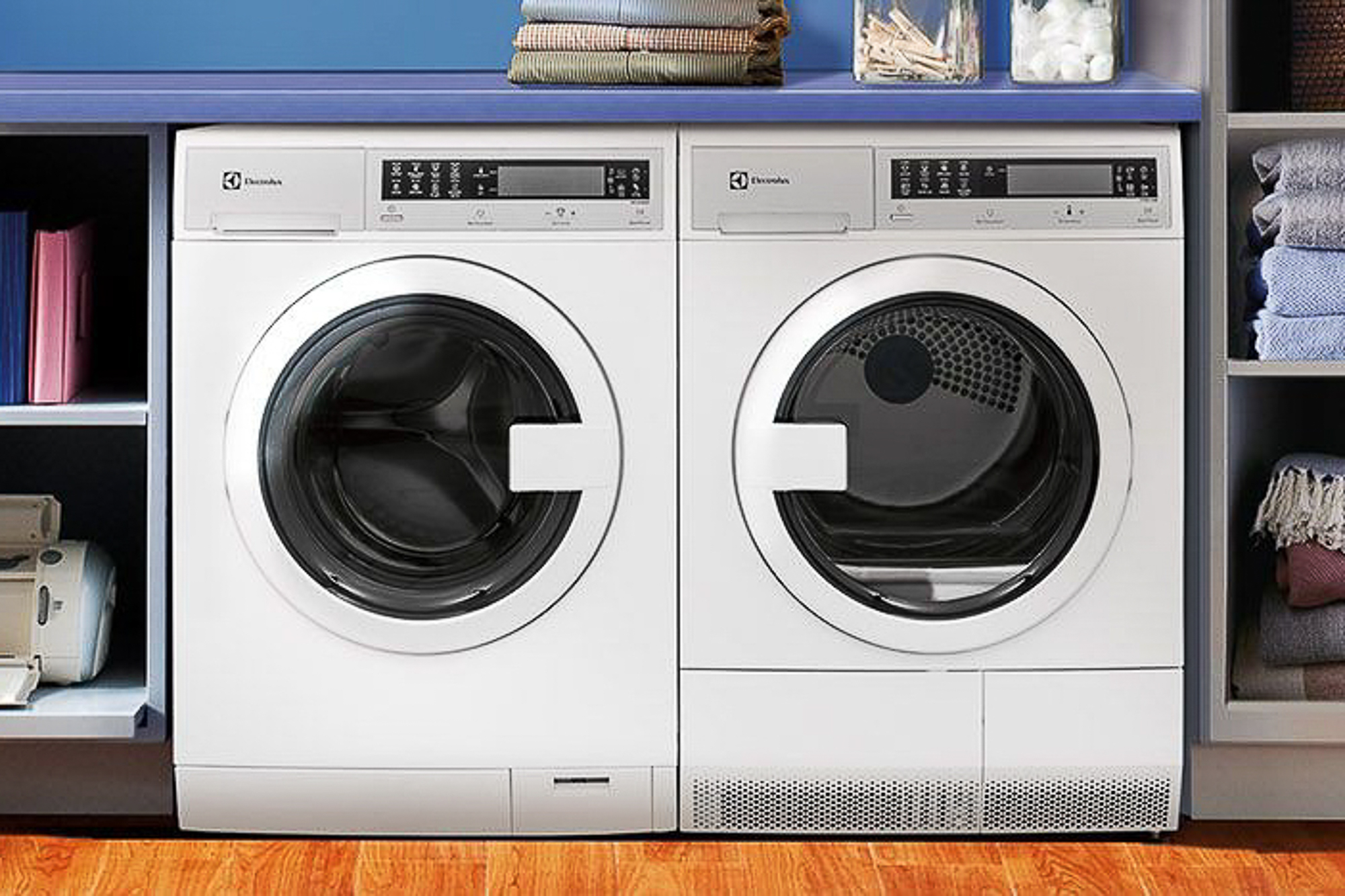Who should get this
If your laundry area doesn’t have enough space for a full-size laundry set, or anywhere to ventilate the dryer, a compact washer or dryer might work instead. Most models are the size of a dishwasher, and they typically have around half the capacity of a full-size machine.
Compact machines tend to cost more than their full-size counterparts, though, so regular-size models are a better value if you can fit them.
How we picked
We focused on 24-inch (or European-style) compact washers and ventless dryers that come in matching pairs. The washing machines are all front-loaders, and the dryers do not require ventilation. This style of laundry can fit in more places around more types of homes than standard-size machines, such as side by side under a kitchen counter or stacked in a small laundry closet. Compacts like these still need most of the same plumbing and electrical requirements as a standard washer and dryer, including hot- and cold-water hookups, a 240-volt outlet, and a drain nearby.
The most important features in any appliance, including compact laundry, are reliability and helpful customer service. We also considered factors such as washer cleaning performance, washer spin speed, accelerated wash cycles, presence of a dryer reservoir, how easy it was to reach the dryer filter, capacity, and amount of noise and light produced.
Our pick: Bosch 300 Series compact washer and dryer

Most people who need a 24-inch (European style) compact washer and dryer should be happy with the Bosch 300 Series WAT28400UC washer and WTG86400UC dryer. Of the few models that fit our criteria, these in particular have most of the features that matter, including the fastest spin speed and a shorter wash cycle. The brand also has a strong reputation for reliability, service, customer support, and performance.
Bosch covers its laundry products with the industry-standard one-year parts and labor warranty, plus a second year of coverage for all parts, and the total cost of replacement for the control board and motor.
The 300 Series washer has one of the highest spin-cycle speeds we’ve seen, at 1,400 rpm, and is one of the few compact washers with an accelerated normal wash cycle—finishing an 8-pound load in 60 minutes rather than 100. This is a big time-saver, but because we haven’t tested the machine, we’re not sure if the speed comes at the expense of fabric care or efficiency.
The washer’s power supply could be a potential dealbreaker: Unlike most washing machines, the WAT28400UC needs a 240-volt outlet. However, you can plug it into the WTG86400UC dryer and piggyback off that connection (any good dryer needs a 240-volt outlet anyway). So if you’re stacking the machines, or installing them side by side, this is not an issue. The dryer also needs to be near a drain. Again, this is a nonissue for most people, because the dryer will be installed next to or on top of the washer, which obviously also needs to be near a drain. Price is another downside for the Bosch 300 Series. It’s the most expensive pair among our finalists by a fair margin.
Runner-up: Electrolux EIFLS20QSW and EIED200QSW

The Electrolux EIFLS20QSW washer and EIED200QSW dryer are the next-best pair if the Bosch’s washer voltage and dryer drainage requirements are a problem. The Electrolux pair gets good ratings for cleaning ability, and has a slightly larger washer capacity than other compact models, as well as the same class-leading 1,400 rpm spin speed as the Bosch. It also tends to cost about $300 less than the Bosch set. However, we came across an uncomfortable number of user reviews about poor reliability and customer service, and it’s also missing an accelerated-wash option.
Because the washer can plug directly into a standard 120-volt outlet, the Electrolux pair also allows more installation flexibility. And the Electrolux dryer can either collect its condensed water in a reservoir, or send it directly down a drain. The Bosch, by comparison, has no reservoir, so it needs to be installed near a drain.
The EIFLS20QSW also has the largest capacity we’ve seen in a compact washer. The drum is 2.4 cubic feet, which can help it hold a few more garments than the 2.2-cubic-foot Bosch 300 Series.
We’re not comfortable making the Electrolux pair our main pick, though, because we came across a few too many troubling reviews about reliability and customer service. Although at the time of writing the EIFLS20QSW washer actually has a slightly higher average user rating than the Bosch 300 Series, the negative reviews are very harsh, citing major malfunctions like control-board failures, drum-suspension problems, and big leaks. Some recent reviews for the Electrolux also cited iffy customer service. We are pulling from a small set of data, and these problems can occasionally happen to any kind of product from any brand—but these reviews popped up more often than we were comfortable seeing for a product with relatively little feedback overall.
A smaller, cheaper, portable option: Panda PAN612SG

Some homes are so limited by space or hookups, or by landlords who aren’t interested in making improvements, that even-smaller, more-portable washing and drying tools are the only option for in-home laundry. For those situations, we think the Panda PAN612SG, a portable washer on wheels, will work. We looked into 19 portable washers, and we like the Panda PAN612SG because the price is low, the features are useful, it can fit up to 12 pounds of laundry, and it doesn’t require any special plumbing or electrical connections. It’s not fully automatic, and it still may not be great for some apartments, but it might be your saving grace from the laundromat. We’d pair that with a folding drying rack like the Polder 2-Tier Mesh Top.
We haven’t tested any of these portable washers ourselves, and we have only user reviews to go off of—no editorial testing. So please, take this as a starting point rather than a strong recommendation.
The Panda’s drain hose is made out of cheap plastic and doesn’t attach to the water outlet very securely, which is a potential flood hazard. If it fails, it will dump gallons of water on your floor, which is a problem for you but a bigger problem for anyone downstairs. This risk is why it’s common for older apartment buildings to completely ban in-unit laundry. So check with your landlord, your lease, or your HOA covenant to see if you’re even allowed to get a portable washer.
This guide may have been updated by The Sweethome. To see the current recommendation, please go here.
Note from The Sweethome: When readers choose to buy our independently chosen editorial picks, we may earn affiliate commissions that support our work.



